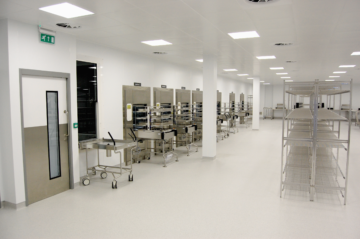With flooring installations in healthcare settings, there is often a particular need for speed to enable areas to be brought back into use as quickly as possible. Furthermore, floors in a poor state of repair can also be a breeding ground for bacteria, causing a contamination risk, making longevity another concern.
Achieving a long-lasting, professional flooring finish requires following best practice in subfloor preparation. In areas subject to high levels of foot traffic and heavy wheeled loads, the use of suitably heavy-duty products is recommended. Products used to install floorcoverings can also have an influence on safety, with some adhesives and smoothing compounds presenting health and safety concerns, while others are specified for their help in infection control. Nowadays, a number of floor preparation products, including waterproof surface membranes, smoothing compounds and adhesives are available that, when used together and applied correctly, allow high performing floorcoverings to be installed quickly, easily and safely.
Moisture management
Before installing new floorcoverings, it is crucially important to check for the presence of moisture in the subfloor. Unchecked subfloor moisture, whether residual construction moisture or rising damp, can attack floorcoverings and adhesives. Not only can this ruin the appearance of installations, or even cause complete floor failure, it can present a health and safety risk by creating a tripping hazard and space for mould and bacteria to grow.
A moisture measurement test should, therefore, be carried out to determine the relative humidity (RH) levels of the subfloor.
The usual method for controlling excess subfloor moisture is the application of a liquid waterproof surface membrane.
Creating a base
Smoothing compounds are now available that are walk-on hard from 30 minutes and allow floorcoverings to be installed from as little as 45 minutes after application, without compromising on quality or finish.
When selecting a smoothing compound for use in biologically sensitive settings, contractors should look for protein-free formulations, which don’t promote the growth of bacteria. Many healthcare facilities will not permit the use of products that contain latex because of the prevalence of allergies to the material.
A time saving solution also exists for situations where floorcovering installations are part of refurbishments which require the removal of old adhesive residues, including bitumen and carpet tile tackifiers. Stopgap 1200 can be used in such scenarios, applied over the top of existing residues, also without the need to prime beforehand, saving valuable time. The smoothing compound is also protein free, making it suitable for use in clinical and biologically sensitive areas.
For preparing subfloors in areas that are subject to heavy loads and high foot traffic, such as hospital wards and corridors, the application of a heavy-duty smoothing compound will ensure the long-term performance of the installation. One such product, Stopgap 300, is latex and protein free, as well as being low odour, meaning it can be used while nearby areas remain in-use and open to the public.
Floorcovering installation
Vinyl sheet and safety flooring are common floorcovering choices in hospitals and other healthcare settings. For this purpose, acrylic adhesives are available that are moisture resistant and protected against bio-degradation, allowing them to effectively withstand deep cleaning procedures.
Solvent-free vinyl adhesives, with a range of additional features, are now available that can also be used to install both floorcoverings and PVC flooring accessories, such as skirting, capping and coving, which are frequently installed in hospitals to make cleaning of floors easier.
Some rapid-drying, flexible cartridge adhesives are also suitable for adhering vertical flooring accessories. The strong bond formed by Stycco Flex, for example, restricts the movement of PVC accessories that occurs over the lifetime of an installation or with temperature changes. This gives the advantage of eradicating gapping at joints – a benefit in healthcare environments, ensuring there is no breeding ground for bacteria.
Compatibility check
To prevent a substandard finish or even complete floor failure, it is always recommended to check the compatibility of particular floorcoverings and adhesives. To do this, contractors can consult the adhesive manufacturer’s Recommended Adhesives Guide or floorcovering manufacturer’s guidance.
